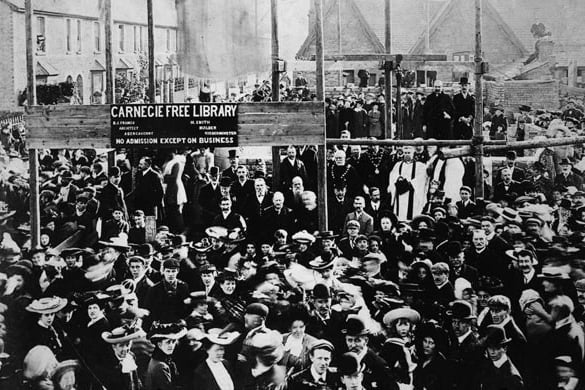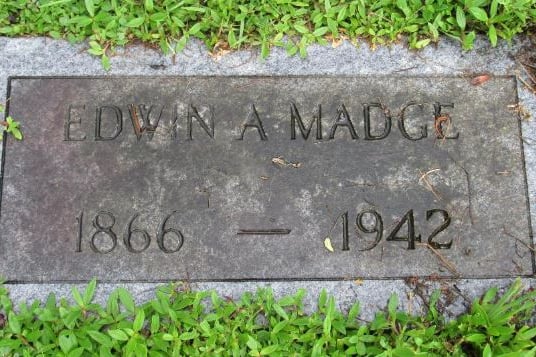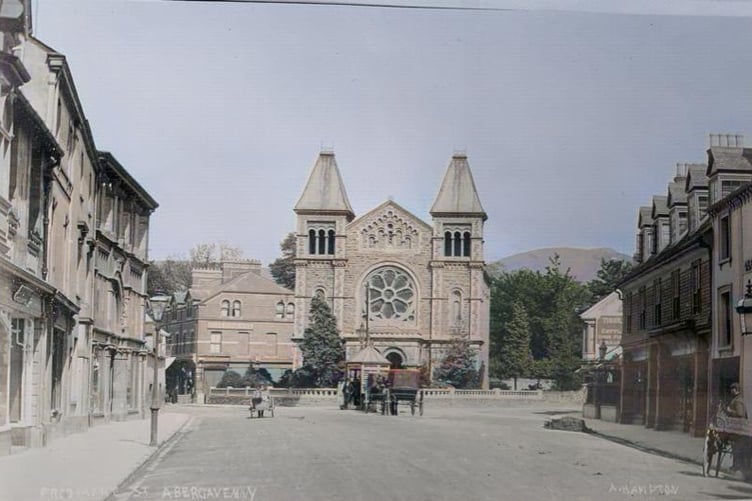EDWIN Arthur Madge was born in 1867 and was from a well-known Morriston (Swansea) family. His first job was a 'boy clerk' with the Great Western Railway at an annual salary of £20.
For some unknown reason he was dismissed in 1883 after less than a year. His next job was a clerk in Morriston tin works, according to the 1891 census, and he got married to a Miss Sarah Davies in Neath the following year.
They had two children before he decided to try his hand in the photography business and move to Abergavenny where they had another four children.
Eddie was already making a name for himself as an artist as his extraordinary talent with crayons was mentioned in a newspaper article in 1893 where he was proclaimed as “one of nature's artistic geniuses.”
The story of Eddie Madge in Abergavenny begins with an advert in the Abergavenny Chronicle dated the 1st of May 1896. It reads: “Wanted – A shop in Brecon Road, with place for studio at back; or front room with place for studio at back – Apply, stating terms, Eddie Madge, artist, Morriston.”
He acquired No. 11 Brecon Road, Abergavenny but by 1901 he had moved to larger premises in Frogmore Street where he stayed until 1912. He carried out his business under the name of West End Studios and also lived with his family on the premises. The Abergavenny Chronicle dated the 24th of May 1901 carried an advert from the new occupier of 11 Brecon Road. He was G. W. Young and he was offering full photographic services.

Eddie still used his talent as an artist and specialised in crayon drawings. There is an article in the Abergavenny Chronicle dated 21st of October 1898 that says he had drawn a portrait of the Prime Minister, William Gladstone, for the Armley Liberal Club in Leeds and a comment was made: “Surely it is to the credit of the town that an Abergavenny artist should be called upon to supply Leeds with a picture of so much importance as this.” Eddie also did a coloured crayon drawing of Christ in Thorns and it is thought that he donated it to St. Mary's Church in Abergavenny but it has since disappeared.
In October of 1899 Eddie made the news for an entirely different reason. He and his wife were coming back from a trip to Raglan and he was driving their horse and trap along the stretch of road by Dobson's farm.
Eddie could see three men in some sort of scuffle taking place in the road and one of the men tried to warn him that the other two were attempting to rob him!
As Eddie drove past the two robbers one of them tried to grab the reins of Eddie's horse, and, being shaken off, clung to the splash-board and then tried to get hold of Eddie who warded them off with his umbrella! The two men gave chase but Eddie still held them off with his umbrella until the horse had been urged into a gallop and left the two men behind. A policeman arrested the men near to the Swan Hotel but they denied all knowledge of any attempt at robbery. The case was proved against them, thanks to the evidence of Eddie and the other victim, and they were fined £5 each or to go to prison for one month with hard labour. They paid the fine.

Over the next couple of years Eddie Madge's name as a photographer appears in many newspaper stories. He seemed to be the first choice for all the local weddings and sports meetings.
The Abergavenny Chronicle of the 24th of May 1901 reported the “Welcome home of our brave volunteers” from the Boer War. These citizen soldiers had responded to their country's call, and like true Britons, had volunteered to go forth and fight in distant South Africa in the cause of liberty and justice. They had been away since the 25th of January 1900, and had all come back except one, and were now enjoying a hero's reception.
Eddie took several photos of the occasion including the reception of the home-comers by the Mayor at the GWR station, the march along Station Road, passing the Swan Hotel and a snapshot of 'our boys' with the Town Council at the rear of the market hall. These photos were now on view in Eddie's studio window in Frogmore Street.
Later in the year, the Reverend W. M. Yorwerth was leaving the district and was presented with a large portrait of himself executed by Mr. Eddie Madge of the West End Studio.
The Abergavenny Chronicle of the 25th of October 1901 reported: “Success of an Abergavenny artist – We are pleased to record the fact that our fellow townsman, Mr. Eddie Madge, has succeeded in winning a share of the second prize of £10, for best photographs of 'Footraces' with six figures running at right angles to the camera, and showing Bailey Park gates and the house on the opposite side of the road, and a picture of 18 men just commencing the race, showing dressing tents etc. in Bailey Park, on the occasion of the athletic sports. The portraits of the runners are perfect in each case. The competition, which was open to the whole of the world, was inaugurated by the Thornton-Pickard Manufacturing Co. who offered £105 in prizes and is an annual affair. Last year the first prize went to Germany and the second to New Zealand. This year the second prize was divided between Abergavenny and Bath.”

In the same year Eddie was awarded two first prizes at the National Eisteddfod held that year in Merthyr Tydfil and added this honour to his weekly adverts in the Abergavenny Chronicle.
In August of 1901, the Abergavenny Chronicle reported a meeting of the Town Council that discussed the issue of a water shortage in the town. It was noted that the Kibby brook had been diverted and this meant that the amount of water now available was being limited to 25 gallons per person per day.
The Council members went on to discuss individual businesses that seemed to be using excess water and Eddie's name was mentioned. Mr. Madge was reportedly using a very large quantity of water at his studio which was not being charged for by meter. Instructions were given to remedy this matter as soon as possible.
In 1903 Burrow's produced their guide to Abergavenny and district that comprised 140 pages with 80 illustrations (photos), most of which were taken by Eddie Madge.
The National Archives has a photo taken in 1906 by Eddie Madge of the Rhymney Royal Male Choir.

In September of 1906 the Abergavenny Chronicle reported that the Lord Mayor of London and the Marquess of Abergavenny had opened the new Carnegie library in Baker Street.
Photographs of the Lord and Lady Mayoress and their entourage were now on display in the window of Mr. Eddie Madge's studio. This event was also covered by the town's other leading photographer, Mr. Harry Shackleton. The report goes on to say that the opening ceremony was also captured on 'excellent moving pictures.'
It seems that Eddie's share of the photography business was declining as other rivals came on the scene. (A census evaluation found that between 1851 and 1861, for example, the number of professional photographers in England and Wales increased by nearly sixtyfold.)
Photography was now becoming easier with the advent of film in the 1880's that replaced the need for cumbersome glass plates. In 1903 Harry Shackleton was advertising a “full and up-to-date stock of photographic plates, papers, chemicals etc. and a well-appointed dark room free for use of customers.
Plates and films developed.” By 1907 Eddie's long running front page advert in the Abergavenny Chronicle came to a sudden halt. At some time over the next few years, he decided to try his luck in North America.
Local newspapers had adverts in 1907 appealing for people to come to Canada and start a new life there. One advert said: “Come to Canada, 160 acres free for unskilled labourers – splendid opportunities for healthy men and women. Britain's nearest and greatest colony.” Eddie's eldest son, David Arthur Thomas Madge, answered this call and sailed to Canada in March 1911 where the 1911 census found him working on a farm in Saskatchewan. Not much is known about him for the next few years but he was drafted into the United States army in 1917.
By 1912 Eddie and the rest of his family had decided to emigrate to the New World. A family legend says that he had tried to book tickets on the maiden voyage of the world's most luxurious liner but they were either already sold out or too expensive. This proved to be very fortunate for Eddie and his family as the ship in question was the Titanic!
They managed to get tickets on RMS Megantic and sailed from Liverpool in July 1912 and landed in Halifax, Canada. (For some unknown reason, Eddie spent a month in Pen-y-fal mental hospital just before they left.)
The West End Studio was taken over by Edward Harrington who retired from the business in 1959, a year before he died aged 77 years. The studio was lit entirely by natural light until the early 1930's when electricity came to Abergavenny and business was recorded slow at first but boomed after the Second World War.
Eddie's first venture in Canada was to purchase a peach orchard but this was not very successful. Perhaps this gave him the idea of trying his luck in the United States where he already had an aunt living in New Jersey City. (A newspaper article in 1903 had announced that his aunt was leaving Morriston to join her husband in the United States.)
Eddie crossed the border from Canada on the 6th of January 1913 and headed for New Jersey City to be with his aunt. He continued with his career as a photographer and artist. His family followed twelve months later after Eddie had found somewhere to settle down.
Eddie moved to Huntington in West Virginia where one of his sons, John Bryn Madge, established a photographic studio with a partner and it was known as Bryn-Allen Studios. The partnership was dissolved in the 1930's and Eddie and John Bryn moved to Coral Gables in Florida where Eddie died on the 28th of January 1942, aged 75 years. He is buried in Woodlawn Cemetery in Miami and has a simple headstone.

The other Madge!
Eddie had a younger brother, Ernest Madge, who followed a similar career as an artist and photographer. They both attended the Swansea School of Art and both won 1st class certificates and a prize for their freehand drawing skills amongst other awards. On the 1901 census Ernest is assisting his brother at the West End Studios in Abergavenny but subsequently returned to the Swansea/Morriston area setting up in business on his own.
In 1903 an unusual story appeared in the local newspaper. A Mr. David Evans had claimed to have walked 31,000 miles to work and back over a period of 22 years, a round trip of 10 miles per day. A drawing of his face, taken from a photograph by Ernest Madge, appeared in the article. In 1907 it was reported that the 38th Annual Morriston Eisteddfod took place and Ernest Madge was one of the adjudicators and he also donated photographic prizes.
The following year, Ernest entered into a limerick writing competition and won first prize. This was something that he was quite good at as he had already notched up 16 firsts and 67 consolation prizes winning a total of £420 in prize money. Ernest's other passion was astronomy and it was reported on the 8th of February 1907 that he had seen a brilliant meteor from his studio at 5:40 PM. Later in the year it was stated that: “Wales now possesses its own telescope maker as part of the hobby of Ernest Madge.”
An astronomical exhibition took place in Cardiff in 1908 and prominence was given to the telescopes and mirrors that had been made by Ernest Madge along with some celestial photographs that he had taken. In 1909 the Astronomical Society of Wales, of which Ernest was a member, put on a lecture by Arthur Mee who gave a talk on Welsh astronomers. (Arthur Mee is famous for his “Children's Encyclopaedia” which featured many articles on astronomy amongst its variety of topics).
Ernest Madge died in 1961 at the age of 84 years and is buried in Morriston cemetery.



.png?width=209&height=140&crop=209:145,smart&quality=75)

Comments
This article has no comments yet. Be the first to leave a comment.